Versailles – A Few Useful Tips for a Winter Visit
Visiting Versailles – isn’t that on every person’s bucket list? It certainly was for my daughter Lenore and I when we made our way out from Paris on a rainy morning in February, 2016. While we couldn’t avoid the crowds inside the palace even in the off season, we still had a very good visit and especially enjoyed the gardens, even in the rain.
History of Versailles
When most people think of Versailles they have the grand palace of Louis XIV, the Sun King, in mind. What was started as a rural hunting lodge by Louis’ father Louis XIII, was transformed by his son into one of the unquestionably great palatial buildings in the world. Louis XIV was so enamoured with the work of the architect Louis Le Vau that he moved the entire seat of the French government to Versailles. From within the walls of the palace Louis managed numerous wars, religious conflicts and colonial expansions. He believed that he had been chosen by God to be king and that by divine right he had the absolute authority to rule over the nation. At a time when the English were gradually dismantling the power of the British royalty, Louis was consolidating power within himself. While he was no doubt a great king in terms of many of his accomplishments and length of reign (72 years), he was in essence a tyrant who was despised and feared by most. He was unable to pass on his greatness to his son and grandson, who did inherit his belief in the divine right of kingship. The seeds of the French Revolution were sown by Louis XIV and his grandson Louis XVI reaped the harvest by losing his head. The man who declared, “L’etat est moi” (I am the state) would have rolled over in his grave to learn that only two generations later, the French king was executed for treason.
However, there is far more to visiting Versailles than just the palace. There are two lesser palaces, the Grand Trianon and the Petit Trianon as well as the fabulous gardens and fountains that many think are more interesting than the buildings. So there is more than enough to occupy an entire day visiting Versailles.
Getting to Versailles
If you are visiting Versailles as part of a tour group then you obviously don’t need to worry about how to get here, but if you are traveling independently, like my daughter and I, then you need to get here on your own. Actually it’s very simple. In addition to the Paris Metro (subway system), Paris also has a vast array of short run trains called the RER system. These are identified by letters and can be taken from many of the same stations as the Metro. To get to Versailles you simply buy a return ticket on the C line which takes about half an hour to get to the Versailles station. From there it’s a ten minute walk to the entrance. Don’t be alarmed by the fact that the city of Versailles has grown up literally to the gates of the palace, because on the other side are the miles of open space that are the gardens.
It’s a good idea to purchase your tickets online in advance of your visit. There are various ticket prices that run the gamut from the passport ticket that lets you in everywhere, to the palace only ticket or a ticket just for the two Trianons and gardens. There are quite a few who qualify for free admission – all under 18, all under 26 EU members, disabled persons and helpers and teachers with a group. Audioguides are included in the entrance price. You can also pay extra for a guided tour in English or French of King Louis’ private apartments. Our admission today is included in the Paris Pass which we obtained on arriving in Paris and saves a lot of money on the admission fees to the major and minor Paris attractions.
Visiting Versailles – The Palace
By leaving as early as possible from Paris I was, somewhat wistfully, hoping to arrive ‘before the crowds’. No chance. As we approach the entrance gate where all visitors go through a security check, I can see dozens of buses already parked on the huge parking area beside the palace. The first item of note is this statue of Louis XIV on horseback in front of the palace he built. Nothing pompous looking about Louis – not!
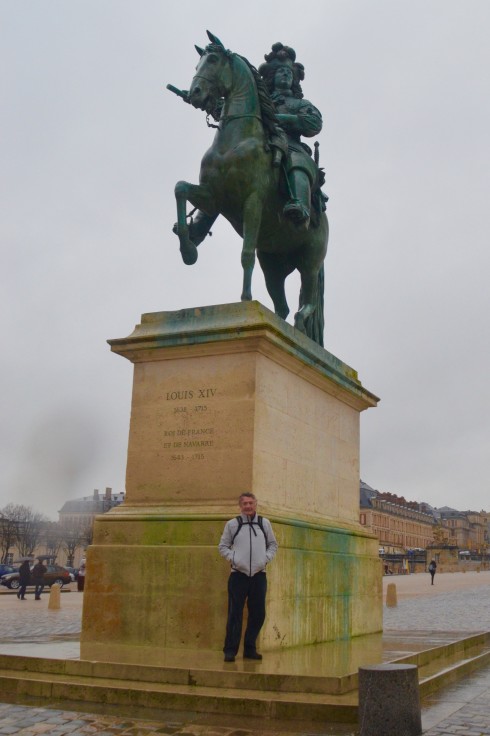
After passing by Louis there’s a chance to stop and get a picture of Lenore outside the palace gates.
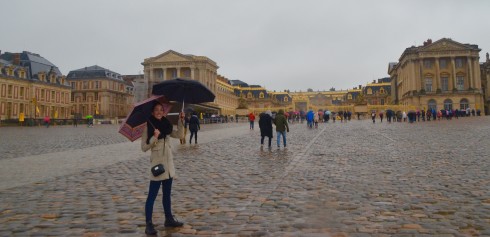
After this you queue up for the security check, which didn’t take very long, and enter the actual grounds through this golden gate where your ticket is validated.
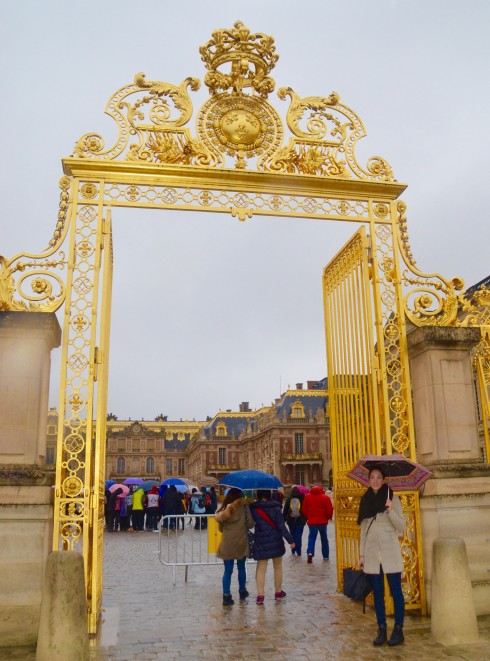
Almost like Moses parting the Red Sea, the hordes of tourists here minutes ago seem to vanish and I am able to get this shot of the exterior of the grand palace.
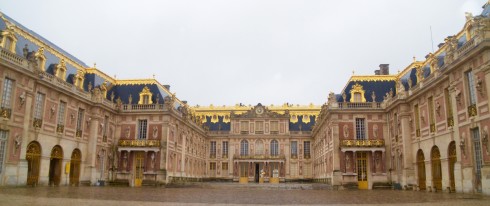
There is no other word to describe the ornate gilded exterior of the grand palace than impressive, although excessive also comes to mind.
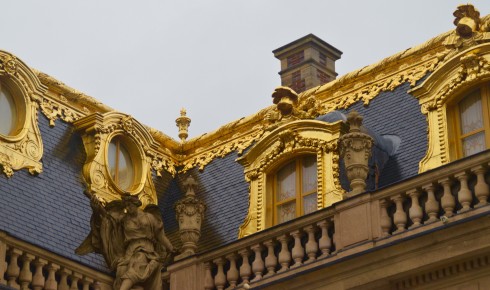
However, this clock is without question a beautiful piece of art.
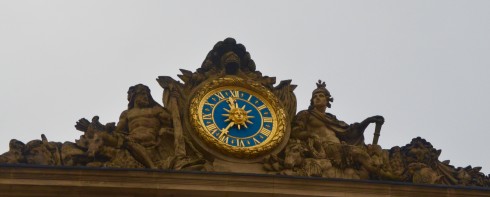
One of the things that makes visiting Versailles so special is not just to view the magnificent architecture, but also to appreciate the decorative arts that compliment it. Under Louis XIV, France arguably was producing some of the best furniture, tapestries, earthenware and other items of interior design, ever made. Great artisans specializing in dozens of techniques flocked to Versailles hoping to gain favour and sell their products to the king.
The entry into the palace proper for individual ticket holders not on a guided tour is through a side door and here you will have to check just about everything but your camera and purse. Non-flash photography is permitted, but I saw dozens of Asian tourists using flashes like nobody’s business. The other thing you should be aware of is that you will be visiting just a small fraction of the entire palace. The bloody place has 700 rooms! There is a one way route for most of the rooms and a lot that you can just look into like the first one of note the Royal Chapel.
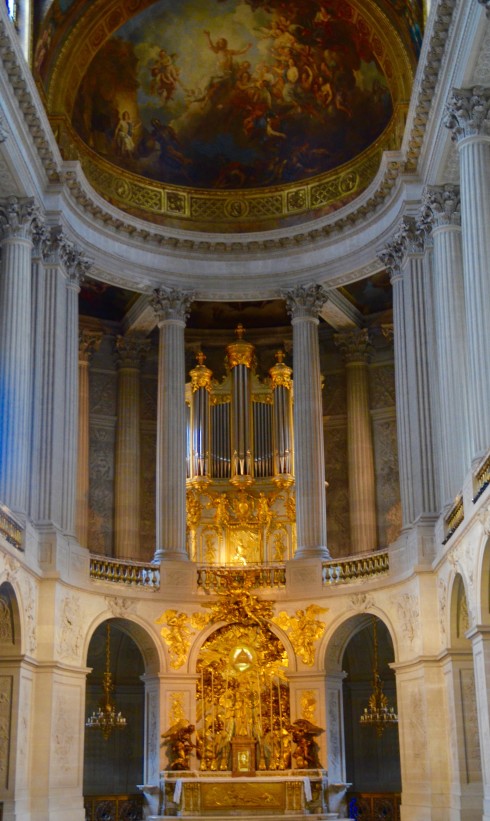
The Hall of Mirrors
Almost right off the bat you come to the most famous room while visiting Versailles – the Hall of Mirrors. Here is what it would look like if empty.
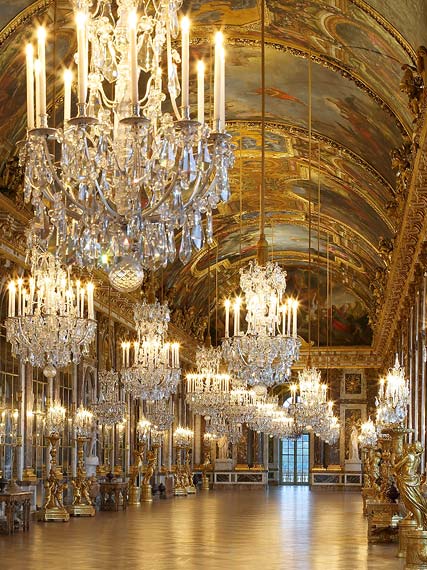
In the Hall of Mirrors you just might be standing in the grandest room ever constructed. Louis XIV deliberately had it built to reflect the glory of France at the height of its power. The room is famous not only for the mirrors that reflect the light from the chandeliers and the windows, but for the hundreds of allegorical depictions of French greatness. Much like the Sistine Chapel, you could spend a lot of time looking up and around just trying to interpret what the various paintings allude to. However, the reality is that the room, as large as it is is jam packed. I took this picture which was full of people before cropping them out.
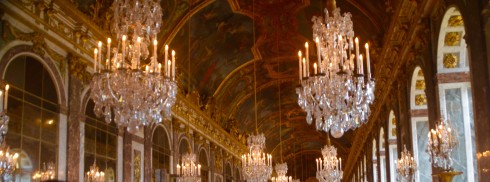
Here is a side shot giving a better idea of the numbers of people.
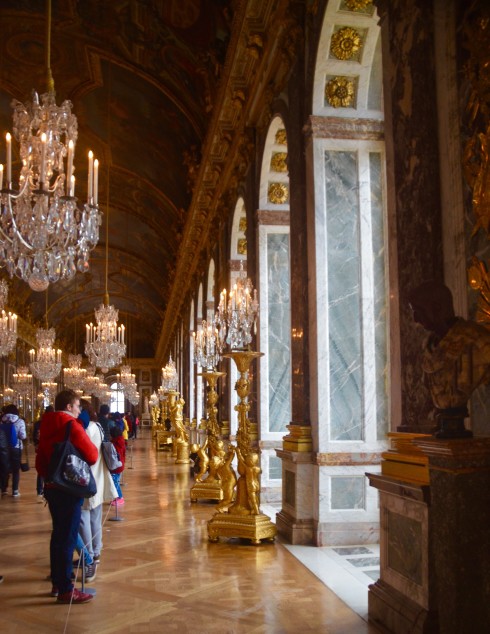
Still, by using a little patience, not my usual forté, I did get this shot of an area with almost nobody in it. Its opulence is pretty stunning, but most visitors will probably be disappointed in the actual mirrors. At the time they were installed the technology for making good mirrors was relatively new. By today’s standards the mirrors aren’t that great, but in terms of the overall effect they more than do their job.
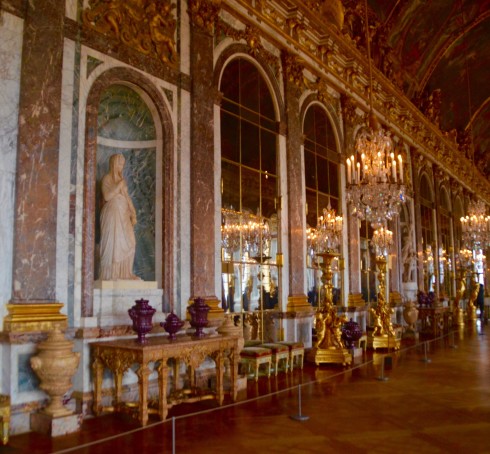
One final note before leaving the Hall of Mirrors, it was here that one of the 20th century’s most famous peace treaties was signed, the Treaty of Versailles. Most people mistakenly think WWI ended in 1918, but what happened on November 11, 1918 was only an armistice or ceasefire. Either side could have taken up arms again, but instead Germany was strong-armed into signed the treaty in this room on June 28, 1919. It was so one-sided that Hitler used it as an excuse to break it and re-arm. Actually it was a bit of payback as the Germans had forced the French to surrender here in 1871 ending the Franco-Prussian War.
Not long after exiting the Hall of Mirrors I came across this gigantic painting of the Coronation of Josephine by Napoleon by the artist Jacques-Louis David. That’s Napoleon placing the crown on her head in defiance of tradition.
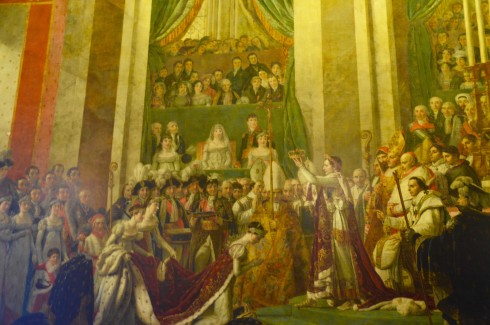
I had to do a double take because I know this painting is supposed to be in the Louvre. As it turns out it is and this is a second version painted by David for some Americans of all people. It eventually made its way back to Versailles where it’s been since 1947.
The Battle Room
If there’s one room at Versailles that might be grander than the Hall of Mirrors it is the Battle or War Room. The contents of this room are dedicated to France’s martial history starting way back with the Battle of Tolbiac in 496 up until the Battle of Wagram in 1809. It was not opened until 1837 and thus not part of the Bourbon’s version of Versailles. You could spend a lot of time examining the details of each of these grand paintings and I did.
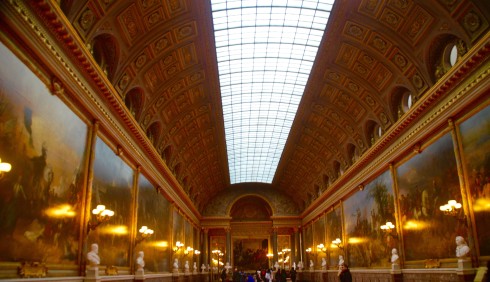
This picture was a surprise. Did you know it was the French that won the Battle of Yorktown and not George Washington? I bet the Americans didn’t. The reality is that the forces at Yorktown were a combined army of French and Americans and that France helped America immensely in its fight for independence.
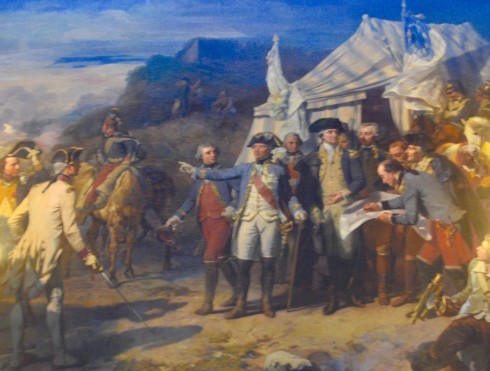
There are long stretches of vaulted corridors lined with statues and busts between the various points of interest. By now the crowds have spread out and occasionally you can find yourself alone, like in this corridor.
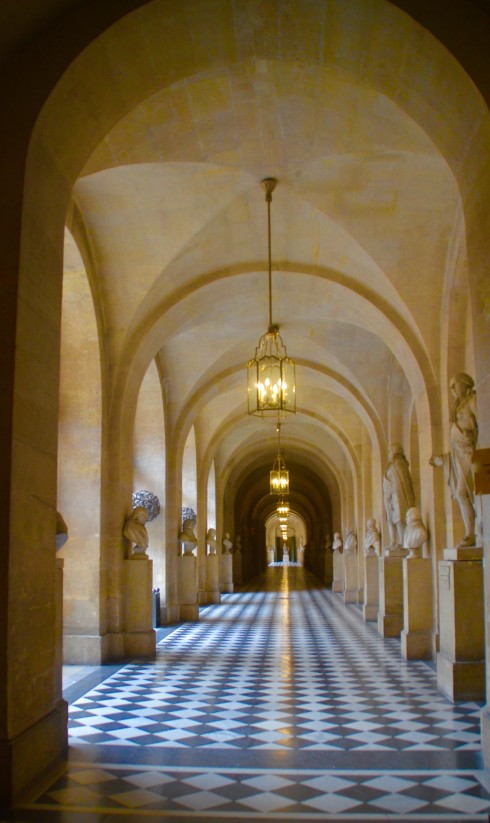
Here I am just hanging with Charlemagne.
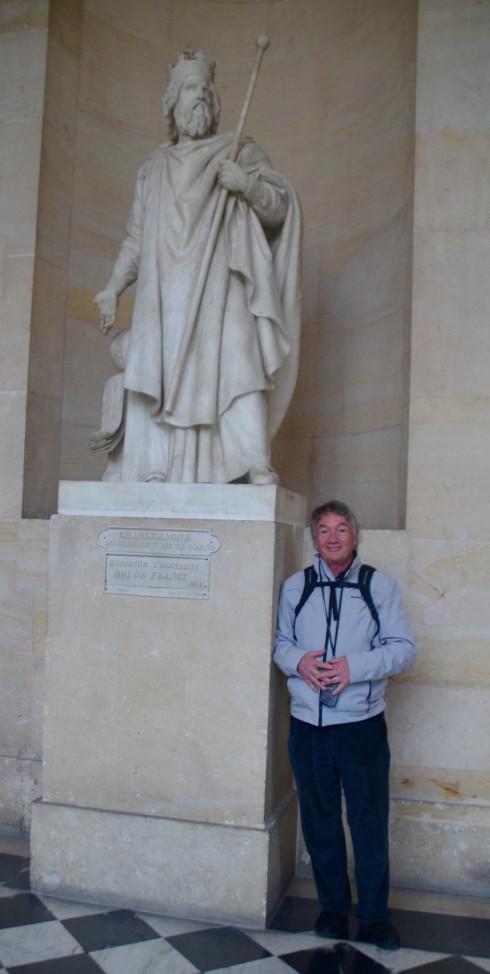
This post would be way too long if I went into any detail about the dozens of rooms that make up the King’s and Queen’s private apartments. Let’s just say that they are sumptuous. However, here’s two examples of the type of decoration and furniture found in the private rooms at Versailles.
These are bedrooms for two spinster daughters of Louis XV who lived here all their lives until the French Revolution. The first is that of Victoire.
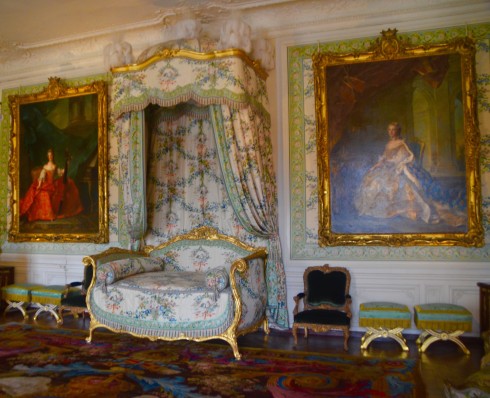
And Adelaide’s.
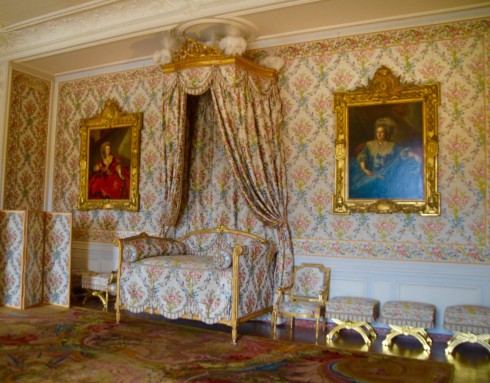
Who could possibly sit in those little chairs?
By now you are ready to exit the main palace and are probably ready for a bite. We were frankly amazed at how tiny and second rate the food facilities are at Versailles, but did notice what appeared to be a real restaurant alongside the Apollo Fountain later in our visit.
Visiting Versailles entails traveling relatively long distances if you are going to visit the two Trianons and the gardens. To make easier to get around, particularly if it’s raining, like today, there is a tram car that shuttles between the main palace and the Trianons. It costs extra and you might have to wait a bit to catch one. but it’s definitely worth it, especially if you are already foot sore from touring the palace.
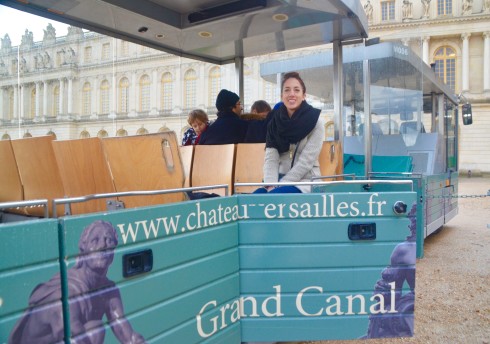
Here is a copy of the official map of Versailles estate. You can make out the grand palace at the bottom. Approaching it from the city side it looks absolutely immense, but when you step out the back side and realize how large the grounds of the estate actually are, the palace comes back into perspective. This is the view that the French royalty would see most often and one that might convince a Sun King that maybe the palace wasn’t so big after all. I’ll come back to the view from the palace at the end of this post.
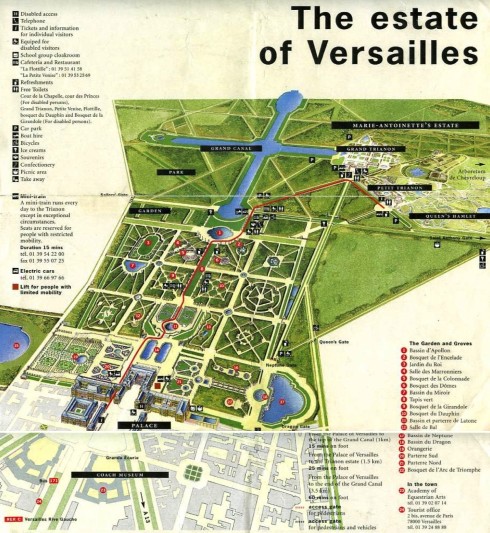
The Grand Trianon
Imagine having a palace so big and so full of people that you had to build another palace just to get away from it all? Well that’s exactly what Louis XIV had architect Jules Hardouin-Mansart do for him in creating the Grand Trianon well away from the main palace. It also helped that he needed a place to conduct his dalliances with his mistress Madame de Montespan. Louis was a serial philanderer and it became a great game for up and comers to try to oust the current mistress. That’s exactly what Madame de Montespan did and it happened to her in turn, but not before she had seven children by him.
After Louis’ death the Grand Trianon was not used much until Napoleon restored it and occupied it on occasion with his second wife Marie-Louise. King Louis-Philippe, the so-called citizen King lived here until deposed in the 1848 revolution. General de Gaulle used it for ceremonial purposes and made part of it an official residence for the French President.
The Grand Trianon is widely reckoned to be one of the most perfectly designed buildings in the world and as we approach I can see why. The combination of marble and porphyry creates the unique pinkness that makes it instantly recognizable. It’s really two separate buildings connected by a peristyle or what we might call a breezeway today.

Here is Lenore at the golden gates of the Grand Trianon. As you get farther away from the grand palace the number of tourists drops off dramatically. Most of the bus tours only do the palace.
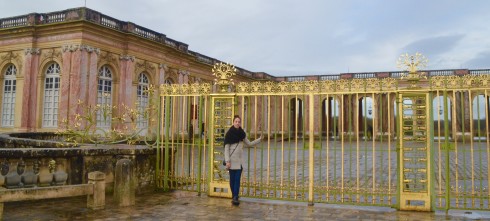
Like the grand palace the tour of the Grand Trianon is one-directional, starting in the left wing going through the peristyle and ending at the end of the right wing. Something like a socialist turning into a conservative. The rooms in the Grand Trianon are certainly palatial, but definitely scaled down in terms of the grand palace. My favourites are –
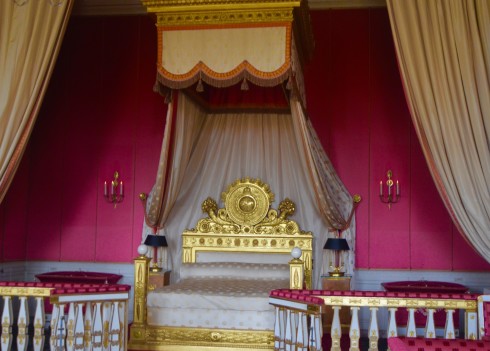
This room was used by Louis XIV, but the colour scheme and bed come from Napoleon.
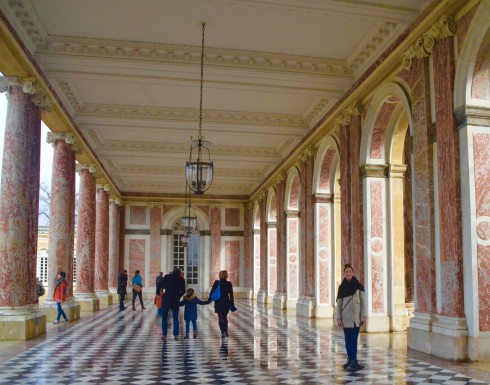
The Peristyle is just plain elegant (and yes I know that’s an oxymoron).
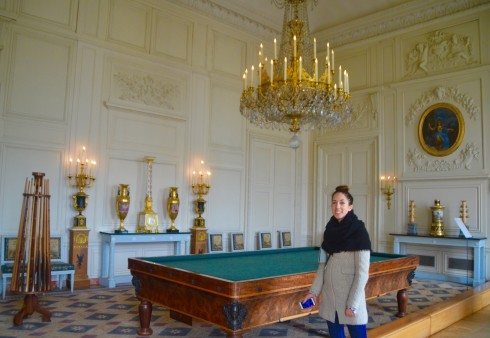
I had no idea that the French royalty played billiards, but this massive table and those super long cues, clearly shows that they did. I wonder why there are no great French players today?
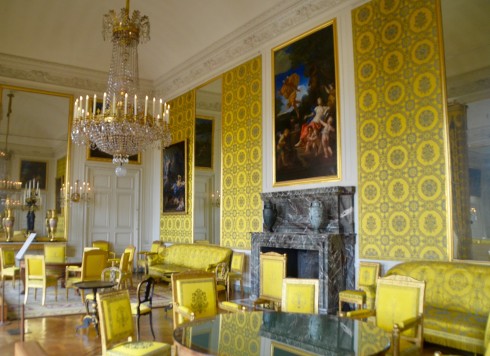
This room had many uses including as Napoleon’s library, but I just called it the Lemon Room.
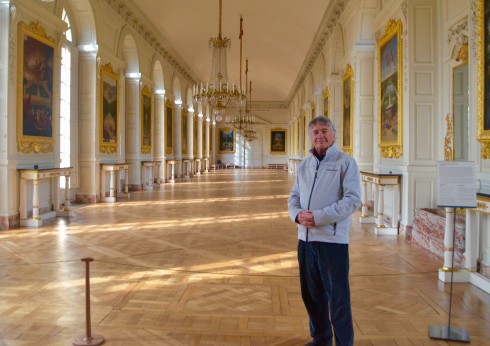
The Grand Cotelle is pretty impressive and named after the architect who designed it, not because they danced the cotillion here, although they certainly could have.
The Petit Trianon
The Petit Trianon is not that far away from the Grand Trianon so we walked instead of taking the tram. Just as Louis XIV wanted a place to be alone with his mistress, Louis XV had the same idea with his mistress Madame de Pompadour when he had it built. However, it’s much more famously aligned with another woman whose name I have assiduously avoiding using up until now – Marie-Antionette. A queen and not a mistress, Marie-Antionette loved this place and completely redid the gardens Louis XV spent a fortune building.
The building itself is not particularly impressive, essentially a two-story square.
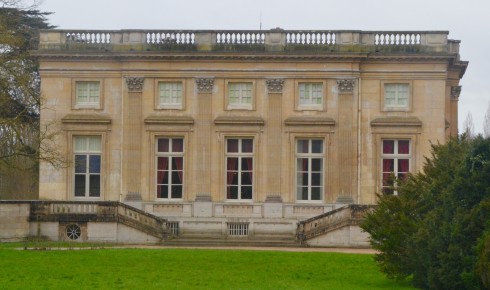
Inside it is, as expected by now, formidably ornate. The Grand Staircase is suitably grand.
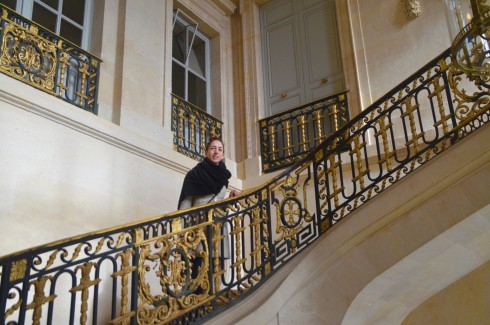
The billiard room has a very famous painting of Marie-Antionette by the celebrated French artist Elisabeth Vigée-LeBrun, one of over thirty she had the artist paint. Do I detect a little vanity in that? Oh and she has a bust of herself as well, in case you weren’t impressed enough by the painting.
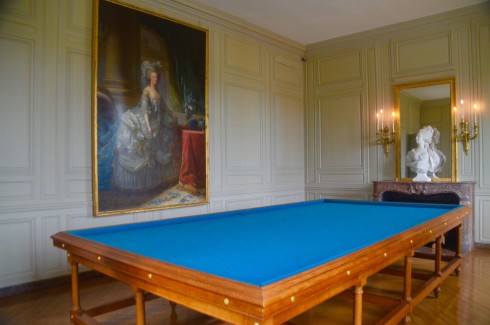
Frankly by now, after three palaces and dozens and dozens of rooms, my brain just can’t compute any more of this opulence. Time to head outside, even if it is still raining.
Marie-Antionette’s Gardens and the Hamlet
If Marie-Antionette had questionable judgment in a number of matters (BTW she never said “Let them eat cake.”) she had great taste in gardens. By her time, Versailles had miles and miles of manicured walkways and ornamental gardens. She wanted something a little more wild and opted for an English style garden complete with follies and man made grottos. Here’s Lenore poking into one of them.
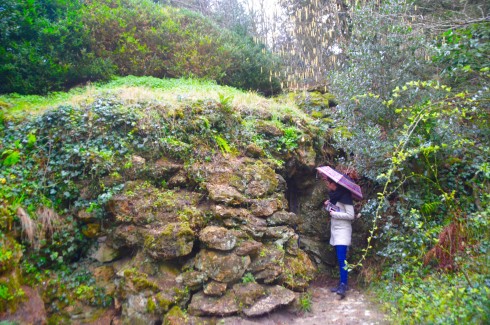
This is the Belvedere, also called the Music Room.
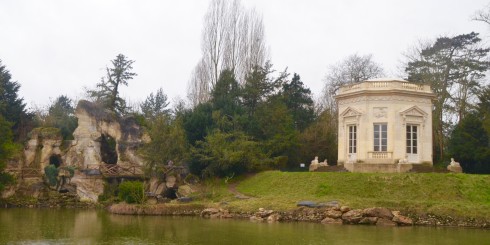
The setting, even though not natural, is the antithesis of the rest of the Versailles gardens and is a nice contrast. She also had a Norman style village or hamlet constructed which you can reach by crossing this bridge.
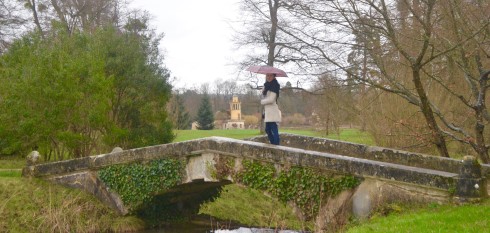
And there it is, complete with the Duke of Marlborough tower.
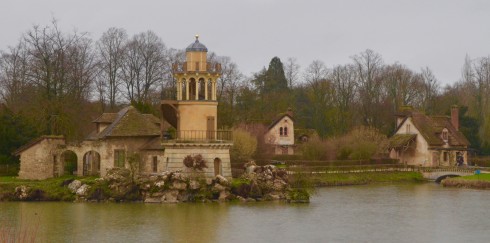
I found the Hamlet to be one of the most interesting and unexpected aspects of visiting Versailles. I had no idea it existed until seeing it. By now the rain is really coming down so we reluctantly head back to the grand palace via the Grand Canal. We are now back to straight sight lines and geometric patterns. On the way back we come across two of the most famous fountains in the world. Not surprisingly the Sun King would choose the Sun God Apollo as the theme of his favourite fountain.
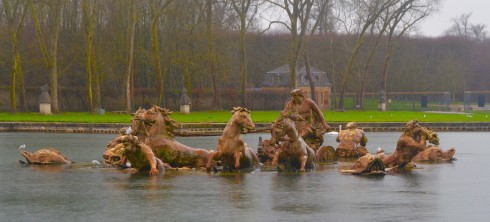
Here is Apollo rising with his horses from the water representing the rising sun from the horizon. Unfortunately the fountains at Versailles are only in operation on limited days, mostly weekends from spring to fall, and they require a special ticket. So most visitors do not get to see this.
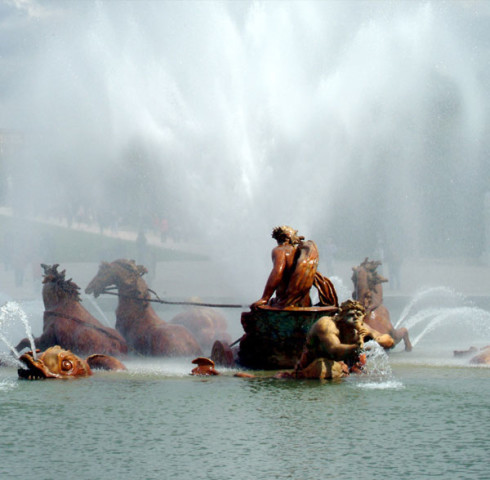
The Latona fountain has another association with Apollo as it depicts the legend of the woman referred to by the Greeks as Leto who was the mother of Apollo and Artemis (Diana to the Romans). Zeus turned a group of jeering Lycians into frogs and turtles, and that’s what this fountain is all about.
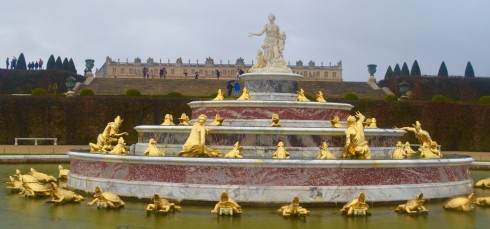
From above the Latona you get this view looking back to the Grand Canal. Pretty spectacular even on a day like today.
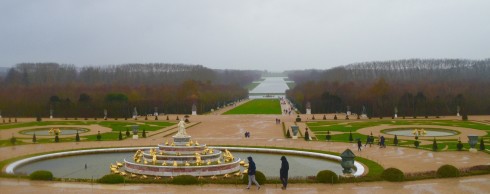
And as I turn around I suddenly realize we’ve got this place to ourselves. I feel like a king.
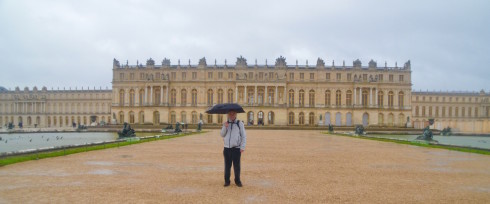
Or maybe a queen?
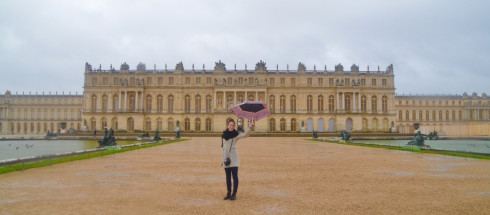
So what would I do differently on my next visit. A few things.
- Stay right in Versailles to take advantage of the many parts of the grounds that you can access directly from the city. There are lots of hotels within easy walking distance.
- Eat in one of the restaurants on the grounds and not in the ones in the palaces.
- Take a private guided tour of the palaces, costs be damned.
- Be there on a day when the fountains are on.
Hope you’ve enjoyed this tour and maybe I’ll see you there on my next visit.
If you are looking for other interesting places to visit in Paris, read my posts on the Pantheon, the Orangerie, the Cluny Museum and walking the Latin Quarter among others.

